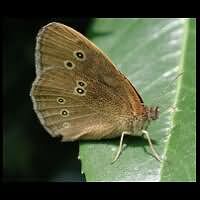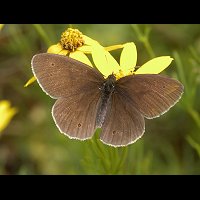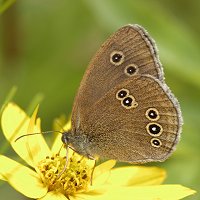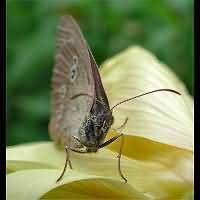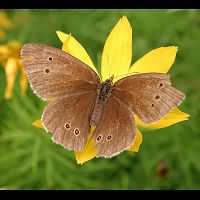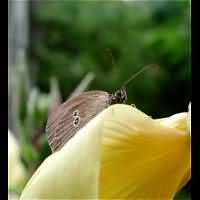Ringlet Aphantopus hyperantus
The most common brown in our garden is the Ringlet. The butterfly is just as big as the Map, but due to the dark and dull colours it is one of the most unnoticed species. The eye-shaped spots can be seen up close only. Sometimes some eight ringlets visit our garden at the same time. The Ringlet hardly ever rests open-winged. Only after a very cold and wet period they will warm up by opening their wings, othertimes they keep them closed together. The females are not only slightly larger, but they also have three eyes near the top of the inside of the forewing. The male usually does with two eyes only and these may be very faint or even lacking at times.
The Ringlet is a very common species all over the British Isles. It is very common in the rest of Europe as well, except for Italy, Spain and Portugal where it is absent in most areas. The female doesn't lay the eggs on plants: she just flies over grasses and drops her eggs one by one. The caterpillar prefers grasses growing in the shade of bigger plants, especially when these are brambles. The larva is brown and has rather long hairs compared to most caterpillars in this family. Both the caterpillar and the pupa are so well camouflaged that they are rarely ever found in grass, despite the animal being extremely common. This species has only one generation flying from the middle of June to the end of August. Males may reach a wingspan of some 38 mm, females are some 4 mm bigger. Just like the other Satyrs and the Brush-footed Butterflies the front legs are not used for walking or resting. That's why the Ringlet seems to have just four legs.
The most common brown in our garden is the Ringlet. The butterfly is just as big as the Map, but due to the dark and dull colours it is one of the most unnoticed species. The eye-shaped spots can be seen up close only. Sometimes some eight ringlets visit our garden at the same time. The Ringlet hardly ever rests open-winged. Only after a very cold and wet period they will warm up by opening their wings, othertimes they keep them closed together. The females are not only slightly larger, but they also have three eyes near the top of the inside of the forewing. The male usually does with two eyes only and these may be very faint or even lacking at times.
The Ringlet is a very common species all over the British Isles. It is very common in the rest of Europe as well, except for Italy, Spain and Portugal where it is absent in most areas. The female doesn't lay the eggs on plants: she just flies over grasses and drops her eggs one by one. The caterpillar prefers grasses growing in the shade of bigger plants, especially when these are brambles. The larva is brown and has rather long hairs compared to most caterpillars in this family. Both the caterpillar and the pupa are so well camouflaged that they are rarely ever found in grass, despite the animal being extremely common. This species has only one generation flying from the middle of June to the end of August. Males may reach a wingspan of some 38 mm, females are some 4 mm bigger. Just like the other Satyrs and the Brush-footed Butterflies the front legs are not used for walking or resting. That's why the Ringlet seems to have just four legs.

